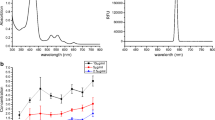Abstract
Photodynamic therapy (PDT) and photodetection with protoporphyrin IX (PpIX) precursors have widely been used in the diseases with abnormally proliferative cells, but the mechanism of the modality is not fully understood yet. In this study 70-95% of apoptotic cells after PDT with PpIX precursor, hexaminolevulinate (HAL) in two human lymphoma cell lines, Namalwa and Bjab, were confirmed by fluorescence microscopy, electron microscopy and flow cytometry. HAL-derived PpIX was mainly distributed in the mitochondria and endoplasmic reticulum (ER), both of which were initial targets after light exposure causing two major pathways simultaneously involved in the apoptotic induction. One was the mitochondrial pathway including the release of cytochrome c, cleavage of caspases-9/-3, poly(ADP-ribose) polymerase and DNA fragmentation factor. The other was the ER stress-mediated pathway triggering a transient increase in the cytosolic Ca2+ level after photodamage to the ER calcium pump protein SERCA2. The released Ca2+ further initiated the caspase-8 cleavage. The use of both extracellular Ca2+ chelator EGTA and intracellular Ca2+ chelator BAPTA-AM confirmed that such cytosolic Ca2+ originated from the ER rather than extracellular Ca2+-containing medium. About 30% of the apoptosis was blocked with BAPTA-AM alone; while a complete inhibition of such apoptosis was achieved with a combination of the caspase-9 inhibitor Z-LEHD-FMK and caspase-8 inhibitor Z-IETD-FMK, thus quantifying each role of the mitochondrial and ER pathways.
Similar content being viewed by others
Abbreviations
- ALA:
-
Aminolevulinic acid
- HAL:
-
Hexaminolevulinate
- PDT:
-
Photodynamic therapy
- PD:
-
Photodetection
- PpIX:
-
Protoporphyrin IX
- EGTA:
-
Ethylene glycol tetraacetic acid
- ER:
-
Endoplasmic reticulum
- TdT:
-
Terminal deoxynucleotide transferase
- FITC:
-
Fluorescein isothiocyanate
- BSA:
-
Bovine serum albumin
References
Q. Peng, T. Warloe, K. Berg, J. Moan, M. Kongshaug and K.-E. Giercksky, et al., 5-Aminolevulinic acid-based photodynamic therapy. Clinical research and future challenges, Cancer, 1997, 79, 2282–2308.
J. M. Gaullier, K. Berg, Q. Peng, H. Anholt, P. K. Selbo and L. W. Ma, et al., Use of 5-aminolevulinic acid esters to improve photodynamic therapy on cells in culture, Cancer Res., 1997, 57, 1481–1486.
T. J. Dougherty, C. J. Gomer and B. W. Henderson, et al., Photodynamic therapy, J. Natl. Cancer Inst., 1998, 90, 889–905.
Q. Peng, Editorial: Photodynamic therapy and detection, J. Environ. Pathol. Toxicol. Oncol., 2006, 25, 1–5.
N. A. Thornberry and Y. Lazebnik, Caspases: Enemies within, Science, 1998, 281, 1312–1316.
H. Tajiri, A. Hayakawa, Y. Matsumoto, I. Yokoyama and S. Yoshida, Changes in intracellular Ca2+ concentrations related to PDT-induced apoptosis in photosensitized human cancer cells, Cancer Lett., 1998, 128, 205–210.
D. Kessel and Y. Luo, Photodynamic therapy: a mitochondrial inducer of apoptosis, Cell Death Differ., 1999, 6, 28–35.
P. T. Daniel, Dissecting the pathways to death, Leukemia, 2000, 14, 2035–2044.
D. J. Granville and D. W. Hunt, Porphyrin-mediated photosensitization—taking the apoptosis fast lane, Curr. Opin. Drug Discov. Devel., 2000, 3, 232–243.
N. L. Oleinick, R. L. Morris and I. Belichenko, The role of apoptosis in response to photodynamic therapy: what, where, why and how, Photochem. Photobiol. Sci., 2002, 1, 1–2.
D. Kessel, Death pathways associated with photodynamic therapy, Med. Laser Appl., 2006, 21, 219–224.
I. Schmid, C. Uittenbogaart and B. D. Jamieson, Live-cell assay for detection of apoptosis by dual-laser flow cytometry using Hoechst 33342 and 7-amino-actinomycin D, Nat. Protoc., 2007, 1, 187–190.
B. Krammer and K. Uberriegler, In vitro investigation of ALA-induced protoporphyrin IX, J. Photochem. Photobiol., B, 1996, 36, 121–126.
E. Buytaert, M. Dewaele and P. Agostinis, Molecular effectors of multiple cell death pathways initiated by photodynamic therapy, Biochim. Biophys. Acta, 2007, 1776, 86–107.
B. Chen, T. Roskams, Y. Xu, P. Agostinis and P. A. M. de Witte, Photodynamic therapy with hypericin induces vascular damage and apoptosis in the RIF-1 mouse tumor model, Int. J. Cancer, 2002, 98, 284–290.
D. J. Granville, H. Jiang, B. M. McManus and D. W. Hunt, Fas ligand and TRAIL augment the effect of photodynamic therapy on the induction of apoptosis in JURKAT cells, Int. Immunopharmacol., 2001, 1, 1831–1840.
B. Nagy, W. C. Yeh, T. W. Mak, S. M. Chiu and D. Separovic, FADD null mouse embryonic fibroblasts undergo apoptosis after photosensitization with the silicon phthalocyanine Pc 4, Arch. Biochem. Biophys., 2001, 385, 194–202.
H. Takahashi, Y. Itoh and Y. Miyauchi, et al., Activation of two caspase cascades, caspase 8/3/6 and caspase 9/3/6 during photodynamic therapy using a novel photosensitizer, ATX-S10(Na), in normal human keratinocytes, Arch. Dermatol. Res., 2003, 295, 242–248.
A. Carpinteiro, C. Dumitru, M. Schenck and E. Gulbins, Ceramide-induced cell death in malignant cells, Cancer Lett., 2008, 264, 1–10.
D. Grebenova, K. Kuzelova and K. Smetana, et al., Mitochondrial and endoplasmic reticulum stress-induced apoptotic pathways are activated by 5-aminolevulinic acid-based photodynamic therapy in HL60 leukemia cells, J. Photochem. Photobiol., B, 2003, 69, 71–85.
A. B. Berger, K. B. Sexton and M. Bogyo, Commonly used caspase inhibitors designed based on substrate specificity profiles lack selectivity, Cell Res., 2006, 16, 961–963.
G. P. McStay, G. S. Salvesen and D. R. Green, Overlapping cleavage motif selectivity of caspases: implications for analysis of apoptotic pathways, Cell Death Differ., 2007, 15, 322–331.
D. Kessel and N. L. Oleinick, Initiation of autophagy by photodynamic therapy, Methods Enzymol., 2009, 453, 1–16.
C. M. Yow, N. K. Mak, A. W. Leung and Z. Huang, Induction of early apoptosis in human nasopharyngeal carcinoma cells by mTHPC-mediated photocytotoxicity, Photodiagn. Photodyn. Ther., 2009, 6, 122–127.
J. Finke, W. Lange, R. Mertelsmann and G. Dolken, BCL-2 induction is part of the strategy of Epstein-Barr virus, Leuk. Lymphoma, 1994, 12, 413–419.
Z. Malik and M. Djaldetti, Destruction of erythroleukemia, myelocytic leukemia and Burkitt lymphoma cells by photoactivated protoporphyrin, Int. J. Cancer, 1980, 26, 495–500.
Author information
Authors and Affiliations
Corresponding author
Rights and permissions
About this article
Cite this article
Shahzidi, S., Čunderlíková, B., Więdłocha, A. et al. Simultaneously targeting mitochondria and endoplasmic reticulum by photodynamic therapy induces apoptosis in human lymphoma cells. Photochem Photobiol Sci 10, 1773–1782 (2011). https://doi.org/10.1039/c1pp05169e
Received:
Accepted:
Published:
Issue Date:
DOI: https://doi.org/10.1039/c1pp05169e




